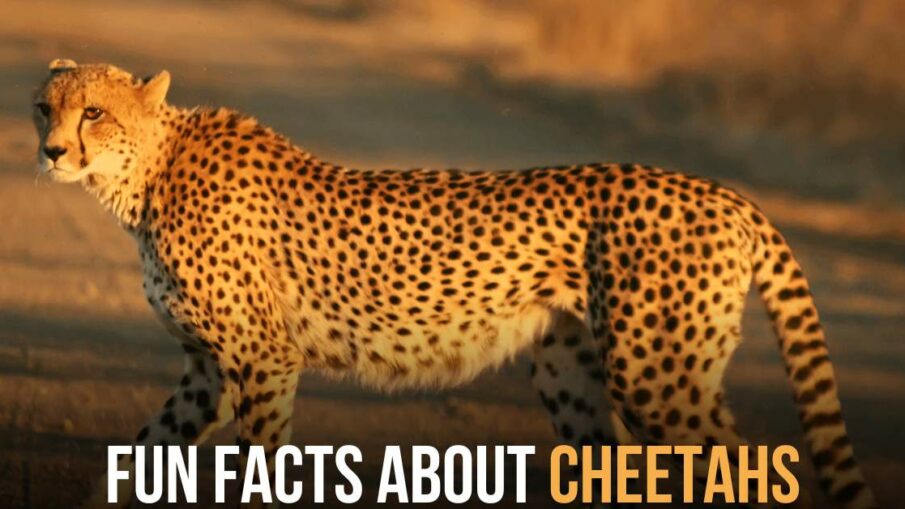Cheetahs, the sprinters of the animal kingdom, are renowned for their remarkable speed and distinctive spots. However, these magnificent creatures hold a world of fascinating secrets beyond their iconic traits. Let’s delve into 18 captivating cheetah facts that reveal the depth of their unique existence.
[ADINSERRTER AMP]
-
Speed Demons of the Animal Kingdom
- Cheetahs claim the title of the fastest land animals globally, capable of reaching speeds up to 75 mph. While they sprint at these astonishing speeds during short bursts for hunting, their average speed hovers around 40 mph. Their impressive acceleration allows them to go from 0 to 60 mph in a mere 3 seconds. The record-breaking cheetah, Sarah, from Cincinnati Zoo, completed the 100-meter dash in an astounding 5.95 seconds.
-
A Myriad of Spots
- When one thinks of spotted animals, cheetahs are among the first to come to mind. These agile big cats boast approximately 2,000 spots that contribute to their unique identity. In the realm of wildlife management, cheetahs can be identified and tracked based on the distinct patterns of their spots.
-
Spots as Camouflage
- Cheetahs’ spots envelop nearly their entire bodies and serve as a clever form of camouflage. These spots contrast with the grayish tones of grasses, enhancing their concealment in the savannah. Cheetah cubs also rely on this camouflage both for stalking prey and for protection against potential predators. Each cheetah possesses a distinctive spot and ring pattern around its tail, akin to human fingerprints.
-
Origin of the Name
- The term “cheetah” finds its roots in the Hindi language, where “chita” means “spotted one.”
-
Male Cheetahs: Social Bonds
- Male cheetahs are unique among big cats for their social behavior. They often form coalitions of 2-3 individuals, aiming to secure as much territory as possible. Remarkably, 70% of these coalitions comprise brothers, but occasional inclusion of outsiders occurs. Male cheetahs generally avoid territorial conflicts with each other, but they may assert territorial dominance over other coalitions or solitary males.
-
Litter Size Variations
- Cheetah mothers typically give birth to litters of 2 to 8 cubs, reflecting their relatively short gestation period of only 90-95 days. Unfortunately, high cub mortality rates persist, both in the wild and in captivity. Newborn cheetah cubs exhibit a dusty-gray coloration with long hair along their backs, referred to as a mantle. These cubs measure around 12 inches in length and weigh just 0.75 pounds at birth. By six weeks, they gain enough strength to participate in hunting, and by six months, they begin practicing on live prey.
-
Silent Roamers
- Cheetahs stand apart from most other big cats like lions and tigers due to their inability to roar. Their voice box’s bone structure resembles that of “small” cats, leading them to produce meow-like sounds. While they can’t roar, cheetahs communicate using growls, hisses, and loud yelps when signaling warnings or feeling threatened.
-
Diverse Subspecies
- Cheetahs exhibit five distinct subspecies:
- Asiatic cheetah
- Northwest African cheetah
- South African cheetah
- Sudan cheetah
- Tanzanian cheetah
- Of these, the Asiatic and Northwest African cheetahs are critically endangered, with populations dwindling in recent years.
- Cheetahs exhibit five distinct subspecies:
-
Eagle-Eye Vision
- In addition to their extraordinary speed, cheetahs possess exceptional vision, enabling them to spot and chase prey from distances of up to 3 miles away. Black tear marks, known as malar stripes, adorn their faces, diverting sunlight away from their eyes and preserving their view, akin to athletes using smudges under their eyes.
-
Daytime Predators
- Cheetahs are unique among big cats for their crepuscular hunting habits, preferring to hunt at dawn and dusk. Unlike other nocturnal competitors like lions, hyenas, and leopards, cheetahs primarily hunt during the day. This adaptation minimizes competition and reduces the risk of kleptoparasitism, where other animals steal their prey.
-
Built for Speed
- Cheetahs’ bodies have undergone numerous adaptations to support their need for speed. They typically weigh around 125 pounds, making them lightweight and easily accelerating. Features like a small head, lean legs, a flat rib cage, and semi-retractable claws minimize air resistance, enhancing their aerodynamics. Their hard foot pads and claws provide traction, while the long tail aids in stability and steering. A cheetah’s flexible spine and hips, along with free-moving shoulder blades, function as a spring mechanism. To support their high-oxygen demands during sprints, they possess enlarged nasal passages and lungs.
-
Lifespan Variations
- Cheetahs in the wild typically live to be around 10 to 12 years old. In captivity, they can reach up to 20 years or longer. The oldest recorded captive cheetah, Dolly, residing in Birmingham Zoo, lived to the grand age of 18. Unverified sources even claim the existence of cheetahs that reached 27 years.
-
Survival without Water
- Cheetahs exhibit remarkable resilience when it comes to water. They can survive for 4 to 10 days without drinking, relying on the moisture from their prey’s bodies to stay hydrated. Their diet includes a diverse range of prey, from rabbits to wildebeest calves and birds, facilitating this adaptation.
-
Pet Prohibition in the USA
- Keeping cheetahs as pets in the United States is illegal. Cheetahs are rare in the U.S., both in the wild and in zoos, due to challenges in breeding and importing them. Legal restrictions ensure their conservation in the wild.
-
Climbing Limitations
- Unlike many other big cats, cheetahs are not natural climbers. Their non-retractable claws, similar to those of dogs, enhance speed but limit their ability to climb trees. Although they occasionally venture up trees to gain height for better visibility in their bushy habitats, it’s a relatively uncommon behavior.
-
Ancient Egyptian Connection
- In ancient Egypt, cheetahs held a revered status. Pharaohs often kept them as pets and hunting companions, a depiction evident in paintings and statues. Furthermore, they believed that cheetahs’ speed would transport the pharaoh’s soul to the afterlife, leading to the practice of burying these magnificent creatures with their owners. Legend even speaks of an Egyptian goddess named Mafdet, depicted with a cheetah’s head.
-
Endangered Population
- Cheetah populations have drastically declined due to habitat conversion, illegal hunting, and the loss of prey species. Today, it is estimated that only around 7,100 cheetahs remain in the wild, and their future is uncertain across their range.
-
Inspiring the Next Generation
- These intriguing cheetah facts provide an opportunity to ignite curiosity and appreciation for these incredible creatures, especially among young learners. For educators seeking to support their teachings, African Animals Coloring Sheets offer a creative way to inspire children while honing fine motor skills and pencil control.
Cheetahs, with their unique characteristics and captivating history, continue to captivate our imaginations and remind us of the remarkable diversity of life on our planet.


Leave a Reply